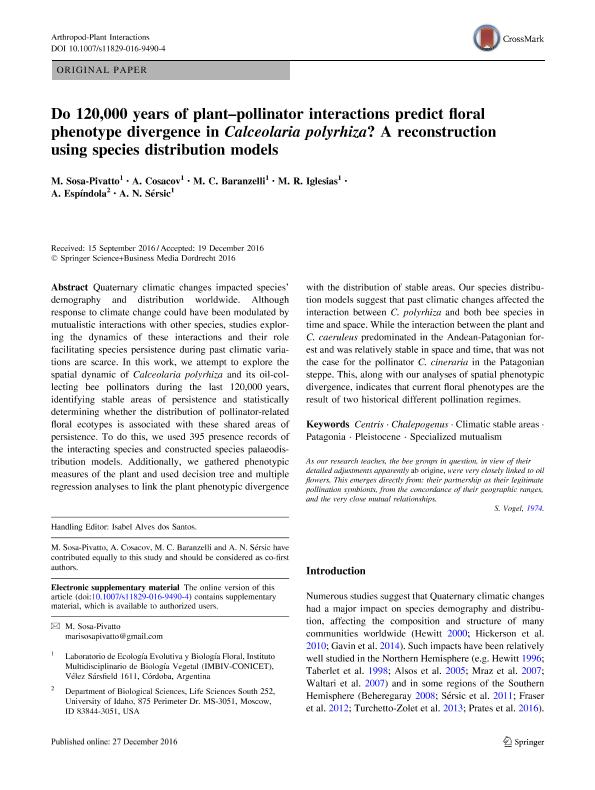Artículo
Do 120,000 years of plant–pollinator interactions predict floral phenotype divergence in Calceolaria polyrhiza? A reconstruction using species distribution models
Sosa Pivatto, María Susana ; Cosacov Martinez, Andrea
; Cosacov Martinez, Andrea ; Baranzelli, Matias Cristian
; Baranzelli, Matias Cristian ; Iglesias, María del Rosario
; Iglesias, María del Rosario ; Espíndola, Anahí; Sersic, Alicia Noemi
; Espíndola, Anahí; Sersic, Alicia Noemi
 ; Cosacov Martinez, Andrea
; Cosacov Martinez, Andrea ; Baranzelli, Matias Cristian
; Baranzelli, Matias Cristian ; Iglesias, María del Rosario
; Iglesias, María del Rosario ; Espíndola, Anahí; Sersic, Alicia Noemi
; Espíndola, Anahí; Sersic, Alicia Noemi
Fecha de publicación:
12/2016
Editorial:
Springer
Revista:
Arthropod-plant Interactions
ISSN:
1872-8855
e-ISSN:
1872-8847
Idioma:
Inglés
Tipo de recurso:
Artículo publicado
Clasificación temática:
Resumen
Quaternary climatic changes impacted species demography and distribution worldwide. Although response to climate change could have been modulated by mutualistic interactions with other species, studies exploring the dynamics of these interactions and their role facilitating species persistence during past climatic variations are scarce. In this work, we attempt to explore the spatial dynamic of Calceolaria polyrhiza and its oil-collecting bee pollinators during the last 120,000 years, identifying stable areas of persistence, and statistically determining if the distribution of pollinator related floral ecotypes is associated with these shared areas of persistence. To do this, we used 395 presence records of the interacting species and constructed species palaeodistribution models. Additionally, we gathered phenotypic measures of the plant and used Decision Tree and multiple regression analyses to link the plant phenotypic divergence with the distribution of stable areas. Our species distribution models suggest that past climatic changes affected the interaction between C. polyrhiza and both bee species in time and space. While the interaction between the plant and C. caeruleus predominated in the Andean-Patagonian forest and was relatively stable in space and time that was not the case for the pollinator C. cineraria in the Patagonian Steppe. This, along with our analyses of spatial phenotypic divergence, indicates that current floral phenotypes are the result of two historical different pollination regimes.
Archivos asociados
Licencia
Identificadores
Colecciones
Articulos(IMBIV)
Articulos de INST.MULTIDISCIPL.DE BIOLOGIA VEGETAL (P)
Articulos de INST.MULTIDISCIPL.DE BIOLOGIA VEGETAL (P)
Citación
Sosa Pivatto, María Susana; Cosacov Martinez, Andrea; Baranzelli, Matias Cristian; Iglesias, María del Rosario; Espíndola, Anahí; et al.; Do 120,000 years of plant–pollinator interactions predict floral phenotype divergence in Calceolaria polyrhiza? A reconstruction using species distribution models; Springer; Arthropod-plant Interactions; 11; 3; 12-2016; 351-361
Compartir
Altmétricas



